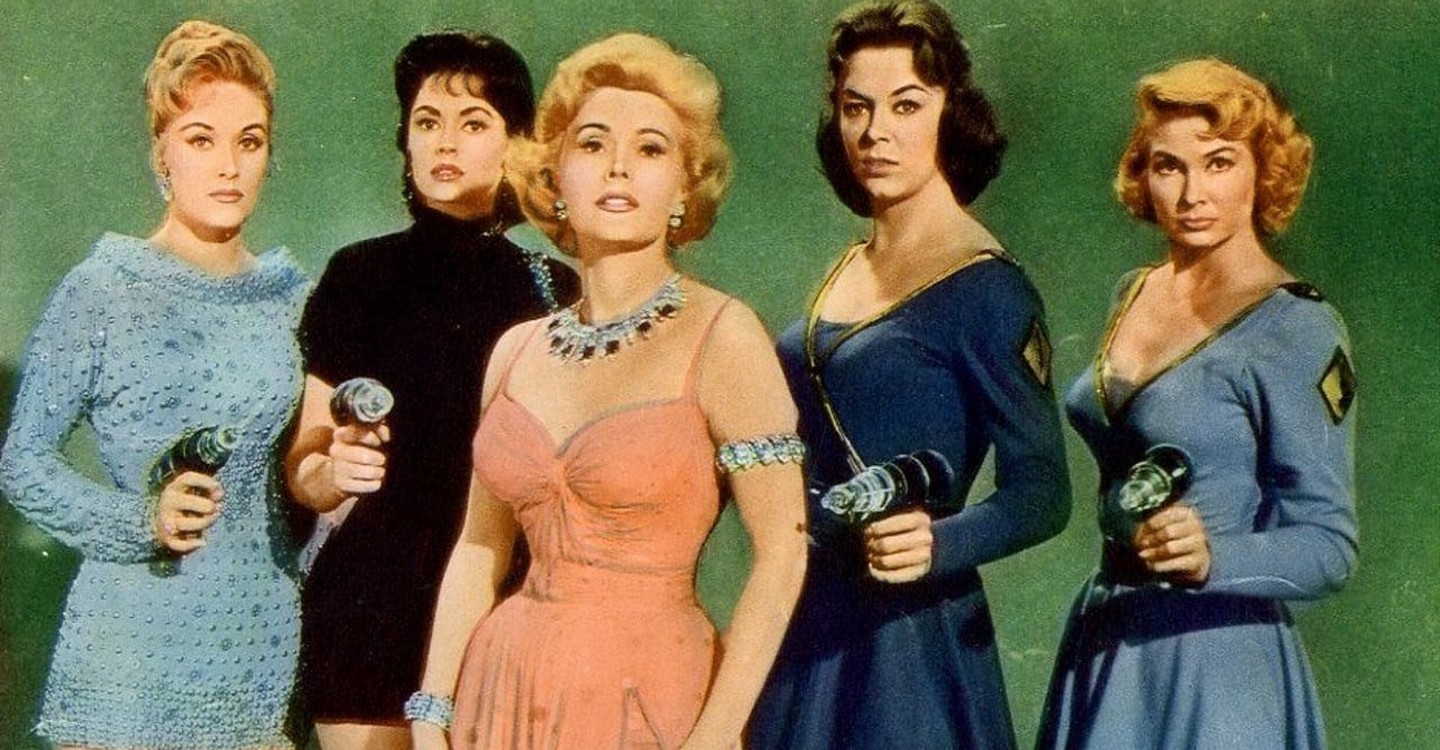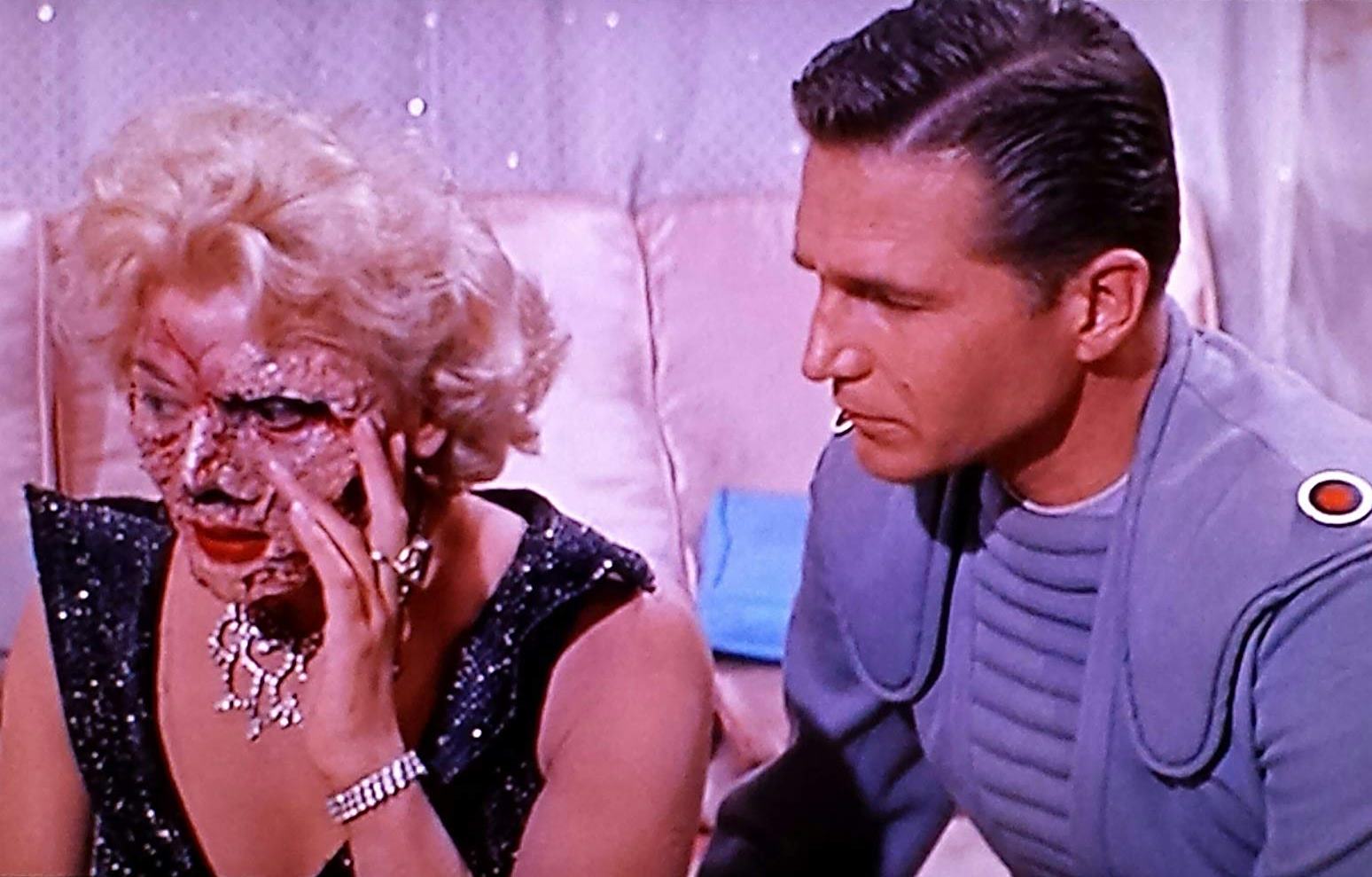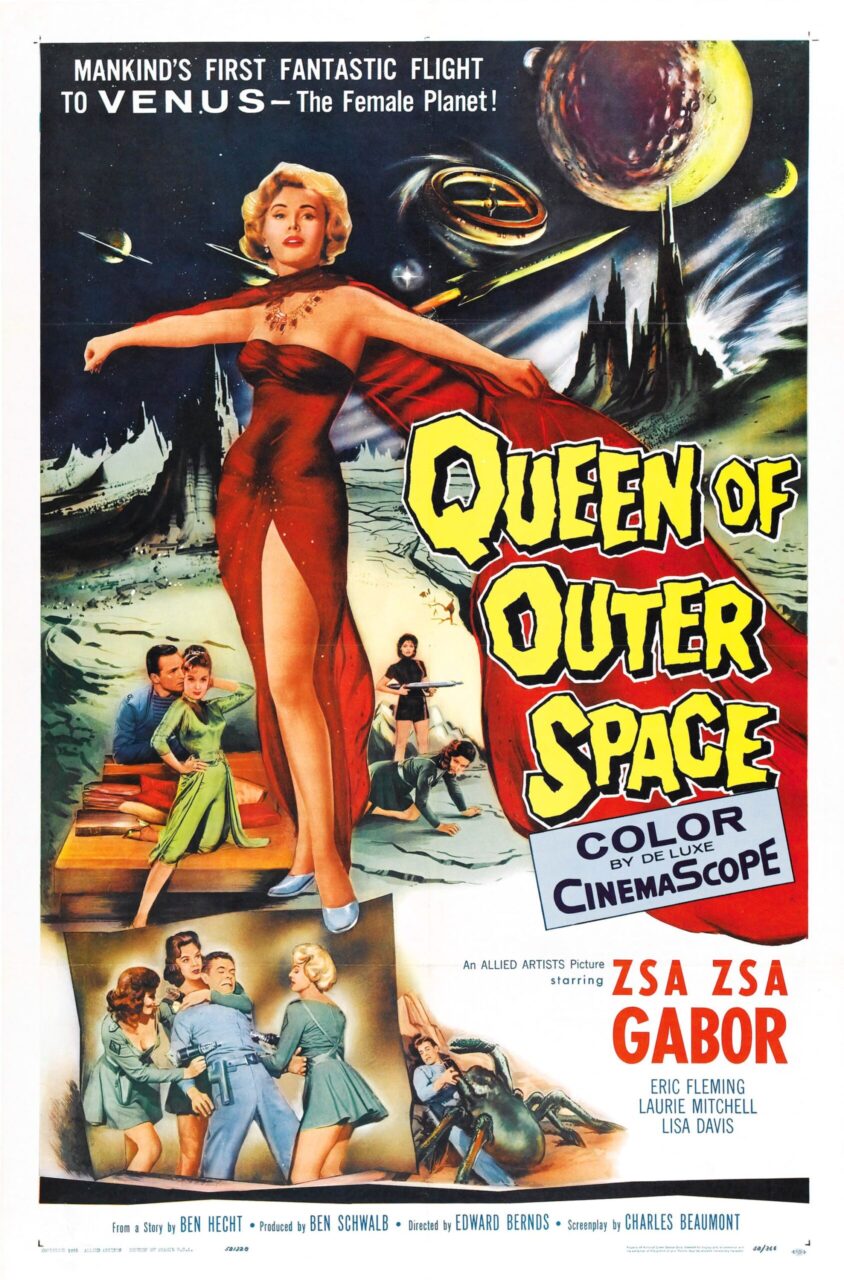USA. 1958.
Crew
Director – Edward L. Bernds, Screenplay – Charles Beaumont, Story – Ben Hecht, Producer – Ben Schwalb, Photography – William Whitley, Music – Marlin Skiles, Special Effects – Jack Cosgrove, Art Direction – David Milton. Production Company – Allied Artists.
Cast
Eric Fleming (Captain Neal Patterson), Zsa Zsa Gabor (Talleah), Patrick Waltz (Lieutenant Larry Turner), Dave Willock (Lieutenant Mike Cruze), Laurie Mitchell (Queen Yllana), Paul Birch (Professor Conrad), Lisa Davis (Motiya), Barbara Darrow (Kaeel)
Plot
A group of astronauts are launched on a routine mission to accompany a scientist to a space station. In orbit, they watch as the space station is destroyed by raybeams. In an effort to avoid being hit by the raybeams themselves, they accelerate to vast speeds and end up crash-landing on Venus. There they are captured by the all-female society, run by the tyrannical masked queen Yllana who has banished all men from the planet. She imprisons the men but they are then contacted by a resistance movement of women who resent Yllana’s rule and want their help in overthrowing her.
Destination Moon (1950) created the great science-fiction boom of the 1950s. It offered a single, wild leap of imagination that said that the stars could be humanity’s for the taking. Despite the deluge of science-fiction films that followed, almost none of them – excepting maybe Forbidden Planet (1956) – accepted the implicit challenge. Instead, humanity’s attitude toward the stars contrarily became one that the sky was in imminent danger of falling on our heads, be it filled with alien invaders or atomic monsters. Space exploration almost entirely dropped from the radar of 1950s science-fiction as a theme, excepting various stories where missions to other worlds served to bring back malevolent aliens.
The sole exception to this might be a small subgenre of films that dealt with what might be termed interstellar sexual fantasies – visits to alien worlds inhabited by all-female societies. These included the likes of Abbott and Costello Go to Mars (1953), Cat-Women of the Moon (1953), Devil Girl from Mars (1954), Fire Maidens of Outer Space (1956), Queen of Outer Space and Missile to the Moon (1958) – all of which are incredibly bad films. They function as male sexual fantasies – firstly, in their conception of space as being inhabited by an excess of desirable and available women, and secondly, in the assumption that such Amazonian societies needed to be tamed and overthrown by a male presence. It is feeble to think that after being presented with the idea of being able to conquer the universe, that all humanity could then imagine was that the only conquering that needed to be done was to put women who had gotten above their station back in their place.
Queen of Outer Space is a terrible film – Plan 9 from Outer Space (1959)-type terrible. Its production values are down around the level of a serial – although to its advantage, it is shot in colour and Cinemascope. The sets look cheap and are extremely limited. There are some good rocket launch sequences – clearly live footage taken from the real space mission – but these do not match the shoddy model sequences once into space, even the design of the rockets is different.

A scene during the opening moments with an uncredited Joi Lansing bidding goodbye to Patrick Waltz – “But spaceships are so dangerous. What if you get lost up there or blow up or something? I wouldn’t know what to do without you” – is astounding in the sheer badness of the acting. Of course, Queen of Outer Space has gained a mini-cult because of the lead role played by Zsa Zsa Gabor – although despite many film guides claim to the contrary, she does not play the title role.
The script comes from people who should have known better, including Charles Beaumont, a fine fantasy writer who wrote 7 Faces of Dr Lao (1964), as well as various scripts for The Twilight Zone (1959-63), the great Night of the Eagle/Burn, Witch, Burn (1961) and Roger Corman’s The Masque of the Red Death (1964). (See below for Charles Beaumont’s other films). The film also has a story from Ben Hecht, one of Hollywood’s most respected screenwriters with the likes of Gunga Din (1939), Spellbound (1945), Notorious (1946) and Kiss of Death (1947). Beaumont clearly knows enough science to be aware that the film’s depiction of Venus with an Earth-like atmosphere is not one supported by science but then throws such considerations away with lines like “You don’t accidentally land on a planet 26 million miles away,” “That’s what I would have said but it appears that all things are possible in space.”
Of all these outer space sex fantasies, Queen of Outer Space is probably the most absurd. The abovementioned fantasies of desirability and of putting women who have gotten the silly notion of running things for themselves into their heads into their place is played to a greater extreme than in all the others. All the women wear bright-coloured mini-skirts with low cleavages and high heels – the effect of them trying to run in high heels and wave around oversized rayguns comes out quite laughably.

Similarly the film shows the women as being unable to do anything on their own and reliant on men to solve problems for them. Beaumont throws in incredibly condescending lines like: “How could a bunch of women invent a gizmo like that [the raygun]?” “And sure if they did, how could they even aim it? You know what women drivers are like?” Even the queen is shown as embittered and hateful of men because of the loss of her beauty and desirability – when her disfigurement is revealed, Eric Fleming’s reaction is not one of understanding or sympathy but to repeatedly regale her about how hideous she looks. Beauty, stupidity and willing subservience, that was what men wanted of women in the 1950s. The film makes the point as clearly as possible.
The director was Edward L. Bernds, a hack on various Three Stooges and Bowery Boys films. Bernds made a number of genre films, including The Bowery Boys Meet the Monsters (1954), Bowery to Bagdad (1955), Jungle Gents (1956), World Without End (1956), Spacemaster X-7 (1958), Return of the Fly (1959), Valley of the Dragons (1961), The Three Stooges Meet Hercules (1962) and The Three Stooges in Orbit (1962).
Charles Beaumont (1929-67) was a noted horror and science-fiction writer during 1950s and 60s. He wrote a number of screenplays including Night of the Eagle/Burn, Witch, Burn (1961), three films for Roger Corman with Premature Burial (1962), The Haunted Palace (1963) and The Masque of the Red Death (1964), The Wonderful World of the Brothers Grimm (1962), 7 Faces of Dr Lao (1964) and the posthumously produced Brain Dead (1990), as well as twenty-two scripts for tv’s The Twilight Zone (1959-63).
The film also features a story from scriptwriter/novelist Ben Hecht (1894-1964) who wrote a number of other classic screenplays with Scarface (1932), Gunga Din (1939), Wuthering Heights (1939), Spellbound (1945), Notorious (1946) and Kiss of Death (1947). In genre material, Hecht also wrote the stomach-churningly pious Catholic films The Miracle of the Bells (1948) and Miracle in the Rain (1956), as well as the Greek myth adventure Ulysses (1954).
Trailer here


